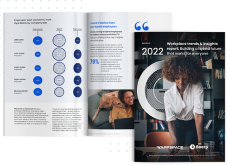
Employee Engagement and Work/Life Balance
Michael Sampson
September 11, 2020As companies have been making the switch to remote work, most employees’ arrangements eliminated the natural boundaries they once had between work and life.
Many employees often struggle with work/life balance. Whether it’s from downsizing the number of people available and piling more work on the already overworked; globalization killing any semblance of a “normal work day” with demands for late night and early morning teleconferences added to already overflowing calendars, employee engagement and a good work/life balance can be hard to achieve.
This is especially true with mobile devices, as they give people the ability to work 24/7. However, they have also become an uninvited guest in the spaces of life that had previously been spared from work demands, causing many employees to log additional hours at the office, at home, or both.
It’s hard to do your best work from a place of exhaustion and overwork. And when work/life balance is out of balance for too long, employee engagement plummets.

Finding balance in the workplace
It’s time for a reset in thinking and practice.
In order for employees to be highly engaged in the long run, work/life balance is essential. Employees need to feel permission to disconnect from work and pursue activities on the life side of the balance. For their own long-term health and wellbeing, people must be very intentional about creating a rich life beyond work alone.
Employers also bear responsibility for employee engagement and work/life balance. The system of the organization can enhance or detract from both, for example in how information is shared, how interruptions are managed, and whether the digital workplace is a disruption factory or a place for streamlined, high focus work.
Creating the organizational environment where people can get their work done during working hours is a critical part of this, so employees don’t feel like they have to sneak into the office at 6 A.M. to leverage the quietness or take work home continually. However, most firms actively create conditions to ensure this never happens.
7 conditions for employee engagement and work/life balance
A digital workplace platform can be leveraged to support high employee engagement and work/life balance.
1. Celebrate life beyond work
Use the communication tools available in your digital workplace platform to celebrate employees (and managers and leaders too!) who are embracing life beyond work in order to show a work/life balance policy in action. This could be a written or video interview with an exemplary employee about their community work, hobbies or sports activities to demonstrate that the organization recognizes life beyond work.
Likewise, employees get a shot of encouragement to pursue their own life activities, safe in the belief that the organization is more than supportive of them doing so. Alternatively, a Work/Life Balance community of interest can share articles, tips and opportunities for employees beginning or progressing on a journey towards better work/life balance.
2. Create opportunities for connection
A digital workplace platform can be used for both doing work and celebrating life beyond work.
Hosting life-focused communities of interest on your organization’s digital workplace platform brings together people with common life interests, e.g., running, swimming, painting, visiting museums, being a new parent, baking bread, etc. These communities of interest enable work colleagues to learn from each other, take inspiration from what other people are doing, and enable employees to contribute ideas and support to others.
The feeling of belonging––of feeling valued and making a contribution––is a strong contributing factor to employee engagement. Many organizations have also found that hosting non-work communities of interest on their digital workplace platform helps with wider user adoption, because skills learnt about engaging with others in these communities are transferable to work-focused communities of practice and project spaces.
3. Support remote working arrangements
Supporting remote and flexible working arrangements benefits work/life balance. More specifically, it engenders the feeling that the organization is aware that work doesn’t have to be done solely at a given place, and that working from home or a cafe offers a space with a different atmosphere for high focus work.
This support also shows that the organization recognizes that employees have other responsibilities in life that can conflict with work schedules at times, like for example, a dentist visit or to be at home to let the plumber in.
Digital work tools in a digital workplace platform, such as collaborative team project sites, can offer anywhere access to the people, applications and data required for getting work done, even without being in the office.
4. Reinforce the bigger picture––and the priorities
The effective use of communication tools in a digital workplace platform enables robust communication to engage employees around the bigger picture and the organization’s strategic priorities.
Direct communication from senior leaders sets the scene for employees to focus on where they can make the largest contribution and be most productive in pursuit of organizational goals, and prioritizes where they should spend their available (albeit limited) time and energy.
Knowing you are getting the right things done is a huge contributor to employee engagement, and the most effective countermeasure to feeling like you’re constantly spinning your wheels on irrelevant busywork.
5. Use open spaces for workflow
Creating team- and group-oriented workspaces in your digital workplace platform for conversation, interaction and task assignments offers a significant benefit for work/life balance, as opposed to the use of closed channels (e.g., email). Specifically, when it’s time for an employee to go home and disconnect from work, other team members who are working a different schedule can respond to and engage with new issues.
The anxiety of dropping the ball or letting colleagues down dissipates with the use of such open workspaces, enabling people to truly disconnect and recharge. And if needed, the history of all interaction is available the next time the employee logs in.
The use of such open workspaces combined with the practice of disconnection when out of work hours has become essential in 2020 when many people are forced to work remotely, thus blurring even more the thinning line between work and life.
6. Automate the mundane but necessary processes
Onboarding a new employee, scheduling leave, and requesting a new laptop are just some of the administrative tasks that employees have to do as part of their employment. A digital workplace platform can be used to simplify and automate such mundane but necessary processes, enabling employees to address all requirements quickly.
Taking an employee experience approach to the design of such interactions between employees and the organizational system reduces the burden of these tasks, enabling people to focus on where they can add the most value.
7. Disallow access outside of work hours?
If you want to take a very hard line on work/life balance as a contributor to employee engagement, you could always adapt your digital workplace to the French model––banning email outside of work hours.
Setting time-based parameters for when employees are actually able to log into your digital workplace would make a very strong statement about the organizational expectation of fully disconnecting and pursuing life outside of work hours. With conditional access policies, it would be possible – if you wanted to go that far.
Getting Started
When it comes to employee engagement and work/life balance, there’s a lot at stake.
Employees who are actively disengaged are not serving your organization nor your customers well. Employees who are exhausted, overworked, and slipping towards the line of burnout will not be able to make a contribution on the job that they can look back on with fond memories in years to come. But equally, there’s lots you can do to rebuild work/life balance and strengthen employee engagement.
Where do you need to start?
.jpg?width=624&name=Beezy_eBook_CTA%20banner-01-01%20(1).jpg)


